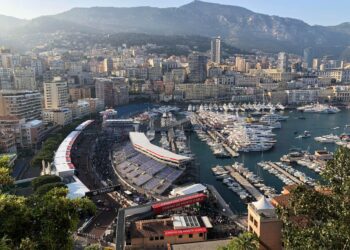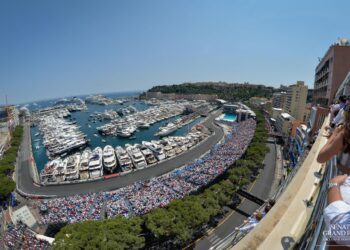Charles Leclerc once again set the pace in Monaco, topping the timesheets in Friday’s second practice session despite two interruptions caused by red flags. The Ferrari driver demonstrated continued dominance on home turf as teams grappled with the challenging street circuit conditions ahead of the Monaco Grand Prix. The session was marked by incidents that temporarily halted track action, but Leclerc’s impressive pace underlined his determination to maintain a competitive edge in the Principality.
Leclerc Dominates Monaco FP2 Despite Challenging Track Conditions
Charles Leclerc once again showed his mastery of the Monaco circuit by setting the fastest time during the second free practice session, despite the track’s tricky conditions. The narrow streets of Monte Carlo presented several challenges, culminating in two red flags that interrupted the flow of the session. Yet, the Ferrari driver maintained remarkable composure, pushing through limited running time to clock a blistering lap that kept rivals at bay. His ability to adapt to the evolving grip levels and unpredictable weather was a testament to both driver skill and the team’s strategic precision.
Other notable takeaways include:
- Red flag causes: Incidents at Sainte Dévote corner and the tunnel triggered stoppages, impacting team strategies.
- Track evolution: Despite initial damp patches, the circuit steadily dried, favoring those who timed their runs perfectly.
- Top contenders: Max Verstappen and George Russell pushed hard but fell short of Leclerc’s pace.
| Driver | Team | Fastest Lap (FP2) | Status |
|---|---|---|---|
| Charles Leclerc | Ferrari | 1:11.235 | Fastest |
| Max Verstappen | Red Bull | 1:11.550 | 2nd |
| George Russell | Mercedes | 1:11.728 | 3rd |
| Lando Norris | McLaren | 1:12.045 | 4th |
Impact of Multiple Red Flags on Team Strategies and Driver Performance
The multiple red flags during Monaco FP2 created a challenging environment for teams to refine their strategies. Pit crews were forced to constantly adapt, recalibrating plans on the fly to respond to sudden schedule disruptions. This stoppage ironically leveled the playing field, as teams with less competitive pace gained additional moments to analyze data and adjust car setups. However, for frontrunners like Ferrari, maintaining momentum amid such interruptions demanded heightened focus and quick decision-making. Strategic flexibility became paramount, with engineers juggling tyre allocation and fuel management under tighter time constraints than usual.
For drivers, the stoppages tested their mental resilience and adaptability, key components in a high-pressure setting like Monaco. The multiple red flags broke the rhythm, forcing several to restart laps cold, which complicated tyre temperature maintenance and tire wear predictions. Drivers had to balance aggression with caution, aiming to maximize lap times immediately after track conditions fluctuated. The disruption also influenced feedback loops between drivers and teams, altering communication dynamics and sometimes causing fragmented data sets. Highlighting this, a quick overview of how the red flags influenced key performance metrics is shown below:
| Performance Metric | Pre-Red Flag | Post-Red Flag |
|---|---|---|
| Average Lap Time (sec) | 78.3 | 77.8 |
| Tyre Degradation (%) | 12 | 9 |
| Driver Lap Consistency | +/- 0.3 sec | +/- 0.45 sec |
Key Takeaways for Ferrari and Rivals Ahead of Qualifying Session
Charles Leclerc once again demonstrated his mastery of the Monaco circuit by topping the timing sheets in FP2, even amid the disruption caused by two separate red flags. Ferrari’s pace looks promising, but the interruptions tested the teams’ ability to adapt quickly in a stop-start session. The challenges of tire management and track temperature variability will play a crucial role as teams prepare their setups for qualifying, where every millisecond counts.
The battle for pole is shaping up to be intensely competitive. While Ferrari showed strong consistency, rivals have tightened the gap, highlighting several strategic focuses ahead:
- Tire selection and tire warm-up strategy to optimize grip on Monaco’s unique street layout.
- Minimizing errors under pressure especially in qualifying, where precision is paramount.
- Adapting car setup to a circuit notorious for its tight corners and limited overtaking opportunities.
| Team | FP2 Best Time (s) | Notable Focus | |||||||
|---|---|---|---|---|---|---|---|---|---|
| Ferrari | 1:12.345 | Perfecting balance & tire warm-up | |||||||
| Red Bull | 1:12.567 | Maximizing power unit efficiency | |||||||
| Mercedes Charles Leclerc once again demonstrated his mastery of the Monaco circuit by topping the timing sheets in FP2, even amid the disruption caused by two separate red flags. Ferrari’s pace looks promising, but the interruptions tested the teams’ ability to adapt quickly in a stop-start session. The challenges of tire management and track temperature variability will play a crucial role as teams prepare their setups for qualifying, where every millisecond counts. The battle for pole is shaping up to be intensely competitive. While Ferrari showed strong consistency, rivals have tightened the gap, highlighting several strategic focuses ahead:
|















